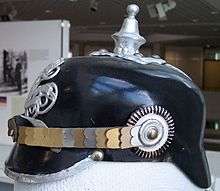Wilhelminism


The Wilhelmine Period comprises the period between 1890 and 1918, embracing the reign of Wilhelm II and the First World War. By Wilhelminism is not meant a conception of society associated with the name Wilhelm, and traceable to an intellectual initiative of the German Emperor. Rather, it relates to the image presented by Wilhelm II, and his demeanour, manifested by the public presentation of grandiose military parades, and self-aggrandisement on his part, this latter tendency having not been unknown to his grandfather Wilhelm I and Bismarck during the period that Wilhelm’s father was Crown Prince. He continued to implement measures against Socialist ideas. His policies, founded on his imperial ambitions, and directed towards the establishment of Germany as a world power, achieved a short-lived high point at the beginning of the First World War, following the acquisition of some colonial possessions in the South Seas and on the African continent.
The distinctive spiked helmet, the so-called Pickelhaube, although it had existed previously, and not only in the German Empire, was symbolic for this period, and for the imperial army and German military (in various sign languages, the extended forefinger placed in front of the forehead, indicating the spiked helmet, is still the sign for “German”).
Wilhelm’s fascination for the German Navy, and his ambition to see it established as an instrument for the projection of world power, were reflected in everyday German life. Until the middle of the twentieth century, boys were dressed in sailor suits, and in this way were impressed at an early age with the Navy’s aura and prestige.
In principle, the dismissal of Otto von Bismarck as Chancellor of Germany in 1890 marks the beginning of the period. The end of Wilhelminism is associated with the end of the First World War in 1918, and the Emperor’s abdication.
The term Wilhelminism also characterizes the social and cultural climate of the reign of Wilhelm II, which found expression in rigidly conservative attitudes. At the same time, the period was distinguished by an extraordinary belief in progress, which, while contributing to the enormous prosperity of the German Empire, was at odds with its social conservatism.
The term is equally applied to styles prevailing in the visual arts and architecture of the period, for example the ornate Germania postage stamps [1] and the Wilhelmine Ring. It is also used to describe, among other things, an essentially neo-Baroque, extraordinarily prestige-oriented style calculated to give expression to the German state’s claim to imperial power. This style was particularly exemplified by the grandiose Siegesallee, lampooned by Berliners as the Puppenallee (“street of dolls”), and was given official status by Wilhelm’s so-called “Rinnsteinrede“ (“gutter speech”) on what he considered modernist degenerate art at the inauguration of the extravagant boulevard on December 18, 1901.
See also
Literature
- Geoff Eley (ed.) and James Retallack (ed.): Wilhelminism and its Legacies. German Modernities and the Meanings of Reform, 1890-1930. Essays for Hartmut Pogge von Strandmann. Berghahn Books, New York and Oxford, 2003
- R. J. Evans (ed.) and Hartmut Pogge von Strandmann (ed.): The Coming of the First World War. Clarendon Press, 1990.
- John C. G. Röhl: The Kaiser and his court: Wilhelm II and the government of Germany. Cambridge University Press, 1966.
- John C. G. Röhl: Wilhelm II : The Kaiser's Personal Monarchy, 1888-1900 - August 2004.
- John C. G. Röhl: Kaiser, Hof und Staat. Wilhelm II. und die deutsche Politik. C. H. Beck, Munich ³1988 (TB 2002), ISBN 978-3-406-49405-5.
- John C. G. Röhl: Wilhelm II., C. H. Beck, Munich 1993–2008:
- Volume 1: Die Jugend des Kaisers, 1859–1888. Munich 1993, ²2001, ISBN 3-406-37668-1.
- Volume 2: Der Aufbau der Persönlichen Monarchie, 1888–1900. Munich 2001, ISBN 3-406-48229-5.
- Volume 3: Der Weg in den Abgrund, 1900–1941. Munich 2008, ISBN 978-3-406-57779-6. (online review by Lothar Machtan, Institut für Geschichtswissenschaft, Bremen University on http://hsozkult.geschichte.hu-berlin.de/)
- Fritz Fischer: Griff nach der Weltmacht. Die Kriegszielpolitik des kaiserlichen Deutschland 1914/18 (1961), Droste 2000 (reprint of special edition, 1967), ISBN 3-7700-0902-9.
References
External links
- Zeitreise – exhibition in Nordrhein-Westfalen
- Preußen – Chronik eines deutschen Staates (ARD series during “Preußenjahr“ 2001)
- Warum der Wilhelminismus als politischer Kampfbegriff nichts taugt - Die Zeit, February 1999